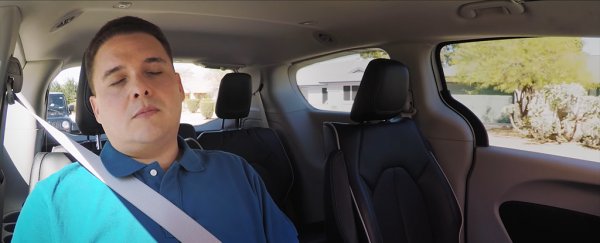What are we going to do with ourselves in the coming years when our autonomous vehicles are doing all the hard work of driving for us? If the latest video from Waymo is anything to go by, we'll be checking our phones, taking selfies, and… nodding off to sleep.
Waymo – the self-driving car company that was spun out of Google in 2016 – is busy testing self-driving cars on the streets of Arizona, and specially invited members of the public are giving the new technology a whirl.
As you can see in the video below, the thrill of the driverless cars soon gives way to a certain amount of boredom and even a quick doze. Seems like even the most exciting new technology gets old fairly quickly.

By the way, you haven't missed the grand arrival of self-driving cars on public roads: these kinds of tests are only allowed in certain areas of the US and other countries, and must only be run by companies that get specific approval from the local authorities.
Waymo is one such company, and it says its fleet of cars now cover 25,000 miles a week in total. Waymo's vehicles are currently being tested in the states of Washington, California, Arizona, Texas, Georgia, and Michigan.
Last year, Waymo got regulatory approval to take a big step towards an autonomous future: it was given the green light to put self-driving cars on the road without a human driver at the wheel.
For a number of years these safety drivers have been doing nothing but monitoring the car's performance, and reassuring passengers, but now they're no longer required by law. The cars are smart enough to operate without a safety net.
Members of the public in Phoenix, Arizona can now apply to be an early rider for Waymo, getting from A to B in a self-driving vehicle, with no one else around.
And judging by this video, we really do fall back to old habits fairly rapidly, whether it's catching up on sleep or checking social media. In a way it's reassuring that these passengers feel so relaxed and comfortable with a software system at the wheel.
What's also quite endearing is the way some of the passengers say "thank you, car" as they get out.
So when can the rest of us have a go? As impressive as the technology inside these cars is, it's not ready for the world at large yet – you'll notice the pre-approved testing regions in the US are largely metropolitan areas with wide roads, clear road markings, and little in the way of bad weather.
Tootling around the sunny streets of California is one challenge – navigating down a dirt track in a snowstorm is quite another. Until self-driving cars can cope with the worst that roads and weather can provide, they won't become legalised.
Still, the technology is making its way into new cars bit by bit. The motors produced by Tesla are perfect examples of this, fitted with an autopilot system that can keep a car in lane and at a constant speed on a highway.
Again, major roads are ideal for getting this technology bedded in: the markings are usually large and clear, the routes are well mapped, and turns and junctions are kept to a minimum.
Along the way to widespread adoption of these vehicles we need to work out how to stop motion sickness when we don't have our hands on the wheel. There's also the rather difficult problem of working out the sort of ethics a self-driving car should have.
In the end though, the benefits could be huge – self-driving car technology has the potential to be much safer and more reliable than flesh-and-blood human drivers ever could be, and that will leave us free to be more productive on our car journeys.
Or just use the time to catch up on sleep.
